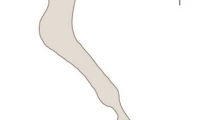Abstract
An annual phytoplankton cycle in lower Chesapeake Bay, Virginia, is described based on data obtained in 1960 on 24 cruises to five stations.
The principal organisms wereSkeletonema costatum, Chaetoceros affinis, C. compressus, Cerataulina bergonii, Chilomonas (?) sp.,Massartia rotundata, Peridinium triquetrum, Gyrodinium aureum (?),Gymnodinium sp.Pyramimonas sp. andCryptomonas sp.
Diatoms were dominant in winter while flagellates were more important during warm periods and late autumn. Both groups were of comparable significance, generally, with flagellates being somewhat more important in the York River and diatoms in the bay proper.
There were four periods of population maxima and six peaks of species diversity. Diversity appeared to spread upbay from the sea during cold periods and downbay from the rivers during warm seasons.
Highest mean population and diversity levels occurred on the western side of the estuary where discharges from several major river systems are received. Despite this indication that environment controls long-term levels of abundance, it could not be demonstrated that nutrients or other specific factors mediated the annual cycle.
Similar content being viewed by others
Literature cited
Braarud, T. 1937. A quantitative method for the experimental study of plankton diatoms.J. Conseil. Internat. Explor. Mer 12:321–32.
— 1945. Experimental studies on marine plankton diatoms.Nordske Videnskaps-Akad., Oslo.I. Mat.-Naturv: Klasse 1944 (10):1–16.
— 1957. Counting methods for determination of the standing crop of phytoplankton.Rapp. et Proc.-Verb. Conseil. Perm. Internat. Explor. Mer (144):17–9.
Burkholder, P. R. andL. M. Burkholder. 1956. Vitamin B12 in suspended solids and marsh muds collected along the coast of Georgia.Limnol. and Oceanogr. 1:202–8.
Conover, S. A. M. 1956. Oceanography of Long Island Sound, 1952–1954. IV. Phytoplankton.Bull. Bingham Oceanogr. Coll. 15:62–112.
Cowles, R. P. 1930. A biological study of the offshore waters of Chesapeake Bay.Bull. U. S. Bur. Fish. 46:277–381.
Cupp, E. E. 1943. Marine plankton diatoms of the west coast of North America.Bull. Scripps Inst. Oceanogr. 5:1–238.
Droop, M. R. 1955. A pelagic diatom requiring cobalamine.J. Mar. Biol. Ass. U. K. 34:229–31.
Fish, C. J. 1925. Seasonal distribution of the plankton of the Woods Hole region.Bull. U. S. Bur. Fish. 41:91–179.
Fisher, R. A., A. S. Corbet, andC. B. Williams. 1943. The relation between the number of species and the number of individuals in a random sample of an animal population.J. Anim. Ecol. 12:42–58.
Gleason, H. A. 1922. On the relation between species and area.Ecology 3:156–62.
Goodall, D. W. 1952. Quantitative aspects of plant distribution.Cambridge Biol. Rev. 27:194–245.
Gran, N. H., andT. Braarud. 1935. A quantitative study of the phytoplankton in the Bay of Fundy and the Gulf of Maine.J. Biol. Bd. Canada 1:279–467.
Griffith, Ruth E. 1961. Phytoplankton of the Chesapeake Bay—an illustrated guide to the genera.Chesapeake Biol. Lab. Contrib. (172):1–79.
Hulburt, E. M. 1956. The phytoplankton of Great Pond, Massachusetts.Biol. Bull. Woods Hole 110:157–68.
Koch, L. F. 1957. Index of biotic dispersity.Ecology 38:145–8.
Lillick, L. 1937. Seasonal studies of the phytoplankton off Woods Hole, Massachusetts.Biol. Bull. Woods Hole 73:488–503.
Margalef, D. R. 1956. Información y diversidad específica en las communidades de organismos.Invest. Pesq. 3:99–106.
— 1957. La teoría de la información en ecología.Mem. R. Acad. Cien. Artes 32:373–449.
— 1957. Temporal succession and spatial heterogeneity in phytoplankton;in Perspectives in marine biology.A. A. Buzzati-Traverso (ed.).Univ. Calif. Press, Berkeley, pp.323–49.
Morse, Dorothy C. 1947. Some observations on seasonal variations in plankton population, Patuxent River, Maryland.Chesapeake Biol. Lab. Publ. (65):1–31.
Mulford, R. A. 1962. Diatoms from Virginia tidal waters.Va. Inst. Mar. Sci. Spec. Sci. Rep. (30):1–33.
Newcombe, C. L., W. A. Horne, andB. B. Shepherd. 1939. Studies on the physics and chemistry of estuarine waters in Chesapeake Bay.J. Mar. Research 2:87–116.
— andA. G. Lang. 1939. The distribution of phosphates in the Chesapeake Bay.Proc. Am. Philos. Soc. 81:393–420.
Nichols, M. M. 1962. Bibliography of the physical, chemical and geological oceanography of Chesapeake Bay.Va. Inst. Mar. Sci. Spec. Sci. Rep. (34):1–43.
Patten, B. C. 1961. Plankton energetics of Raritan Bay.Limnol. & Oceanogr. 6:369–87.
— 1962. Species diversity in net phytoplankton of Raritan Bay.J. Mar. Research 20:57–75.
— andJ. R. Lacey. 1961. Distribution of ammonia nitrogen in the lower York River, Virginia, Spring 1961.Va. Inst. Mar. Sci. Spec. Sci. Rep. (25):1–3[4–13].
Preston, F. W. 1948. The commonness, and rarity, of species.Ecology 29:254–83.
Pritchard, D. W. 1952. Salinity distribution and circulation in the Chesapeake Bay estuarine system.J. Mar. Research 11:106–23.
Riley, G. A. 1952. Hydrographic and biological studies of Block Island Sound. Phytoplankton of Block Island Sound, 1949.Bull. Bingham Oceanogr. Coll. 13:40–64.
Rodhe, W., R. A. Vollenweider, andA. Nauwerck. 1958. The primary production and standing crop of phytoplankton;in Perspectives in marine biology.A. A. Buzzati-Traverso (ed.).Univ. Calif. Press.Berkeley, pp.299–322.
Smayda, T. J. 1957. Phytoplankton studies in lower Narragansett Bay.Limnol. & Oceanogr. 2:342–59.
Verduin, J. 1956a. Energy fixation and utilization by natural communities in western Lake Erie.Ecology 37:40–50.
— 1956b. Primary production in lakes.Limnol. & Oceanogr. 1:85–91.
Williams, C. B. 1952. Diversity as a measurable character of an animal or plant population.Colloq. intern. C. N. R. S. sur l'Ecol. Paris, 1950:129–44.
Wolfe, J. J., B. Cunningham, N. F. Wilkerson, andJ. T. Barnes. 1926. An investigation of the microplankton of Chesapeake Bay.J. Elisha Mitchell Sci. Soc. 42:25–54.
Author information
Authors and Affiliations
Additional information
Contribution No. 127 from the Virginia Institute of Marine Science, Gloucester Point, Virginia, aided by Contract Nonr (NR. 104-581) with the Office of Naval Research, Department of the Navy.
Rights and permissions
About this article
Cite this article
Patten, B.C., Mulford, R.A. & Warinner, J.E. An annual phytoplankton cycle in the lower Chesapeake Bay. Chesapeake Science 4, 1–20 (1963). https://doi.org/10.2307/1351291
Issue Date:
DOI: https://doi.org/10.2307/1351291




